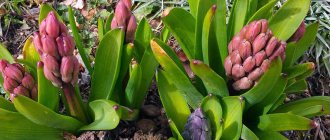This flower belongs to the plantain family; in total there are more than 50 species of antirrhinum (or snapdragon). Among them there are climbing and erect species. They are most often found in warm regions, but most varieties of antirrinum grow in North America.
Snapdragon belongs to the plantain family.
This flowering perennial has many names: dogs, biting dragon, cleft mouth, mouth. And all of them were given to the plant because flowers grow in inflorescences that look like an opening mouth.
This flowering plant appeared in flower beds at least 5 centuries ago , and breeders began to develop new varieties of snapdragon almost two centuries ago. Since then, a large number of new varieties of snapdragon have appeared - more than 1000. And Antirrinum major was taken as the basis for the development of all these varieties.
What does the snapdragon flower look like?
Snapdragons are erect subshrubs or herbaceous perennials. Their shoots are straight, tall (from 0.15 m to 1.0 m), strong, well branched, finely grooved green in color. The shoots form pyramidal bushes. The upper foliage is alternate, the lower foliage is opposite. Its shape is oval, slightly elongated, its color varies from light emerald to dark, the veins are light red.
The flowers are medium in size, irregular in shape, and have two lips. Varieties have been bred with simple and double flowers, which are collected in spike-shaped inflorescences. Their colors are white, yellow, pink, light fawn, and all shades of red are also found. But breeders have developed new varieties with two- or three-color flowers.
We also recommend reading:
16 most popular indoor plants Physalis: description of species and varieties, technology for growing from seeds Spruce in landscape design: the best ornamental varieties and characteristics of cultivation Kalanchoe: description of types and characteristics of care at home
The fruit is a capsule consisting of two nests, which contains a large number of small seeds (one gram can contain up to 1000 pieces).
The flowering of this herbaceous plant begins in the first ten days of June and ends with the onset of cold weather.
Flowering of snapdragon begins in the first ten days of June and ends with the onset of cold weather
When to collect seeds
Antirrhinum seeds are collected in the incomplete maturity phase. The planting material will fully ripen during drying. It is necessary to wait until the fruits located at the bottom of the flower arrow ripen. After this, the upper part of the peduncle is cut off and thrown away, and a paper bag is put on the remaining part of the shoot and tied with thread from below (under the boxes).
Then the peduncle is cut below the tying point and hung in a dry, warm place to dry. After ripening, the seeds spontaneously spill out of the capsules. They are poured into a paper envelope or small cardboard box and stored in a dry place at a temperature of 3-5 ° C.
Types and varieties of snapdragon
There are several types of classifications of this garden flower. The most common of them is based on plant height. There are the following groups of snapdragons:
- high (used for cutting) – above 0.7 m;
- universal (medium height) – 0.4-0.6 m;
- low – 0.25-0.4 m;
- dwarf - 0.15-0.2 m.
Among the tall species, the most popular are the following new varieties: F1 Red XL, F1 Pink XL. The shape of these bushes is narrow pyramidal, and the inflorescences are rich and bright in color. But older varieties are also popular among gardeners:
- Alaska - blooms in mid-summer, flowers are white with a green tint;
- Canary - with yellow buds;
- Anna German – soft pink;
- Ruby;
- Pink, etc.
Dog flowers photo: names and myths
As has long been the case, there are many names for plants that grow in one place or another. In Russia they are often called “dogs”, and in Ukraine “mouths”, in romantic France for some reason the name “cleft palate” has stuck, and in Great Britain “biting dragon or snapdragon”. Translated from Greek, where snapdragon appears to come from, “antirrhinum” literally means “nose-like” or “nose-like.”
In ancient Greek mythology, there is a story about the first of the twelve labors of the mythical hero Hercules, in which he was able to defeat the fierce and invincible Nemean lion. For this feat, from the goddess Flora, Hercules was honored to receive a flower created especially for him. She called him “snapdragon.” It is from this moment that there is a tradition according to which all winners are given this unusual flower.
This plant is about 500 years old, but a German scientist first began to develop new varieties only in the 19th century. Nowadays, there are about 1000 varieties of this plant. All of them were bred thanks to a single species called Antirrhinum majus.
Features of ampelous snapdragon
The ampelous snapdragon was created by breeders specifically to grow these flowers in pots. Due to the fact that such varieties are too tender and do not tolerate low temperatures, ampelous varieties cannot be grown in open ground in the Moscow region and other regions with similar climatic conditions.
These varieties have stems hanging down, up to 0.8-1.0 m in size, and their buds are collected in racemose inflorescences. They bloom from the third decade of June until frost. The most popular variety is the hanging “Lampion”, the length of the stems can reach 0.8-1.0 m.
The ampelous snapdragon was created by breeders specifically to grow these flowers in pots
Reproduction methods
Two methods are used: cuttings and planting seeds. In the first case, a bush is dug up in the fall and planted in a pot until spring. Pre-prepare the plant: remove wilted leaves, shorten the shoots, water rarely, place the pot in a cool room (about +5...+6°C) so that the bush can rest.
From February, the process of awakening the snapdragon begins: watering is carried out more often, the temperature is gradually increased. After the young shoots appear, the cuttings are cut and rooted according to the standard scheme: in a mini-greenhouse, in soil made from a mixture of sphagnum moss and peat. After rooting (up to 3 weeks), after another 14 days, the grown, hardened and strengthened snapdragon is planted in open ground.
The process of propagation by seeds is described in detail in the previous sections.
Technology for growing snapdragons from seeds at home
In nature, snapdragon is a perennial plant, but in garden plots it is often grown as an annual. Therefore, flower growers who grow these flowers in the Volga region, the middle zone, the Urals and Siberia, have to first grow seedlings from seeds at home. How to do it right?
This process is not too labor-intensive, so even a beginner can handle it. Seeds for seedlings should be sown in the first ten days of March in containers with a diameter of about 11-12 cm. These containers must have drainage holes. The soil mixture that is poured into the bowls consists of several layers: coarse river sand is poured onto the bottom, and the next layer consists of compost mixed with sand. The soil should be compacted, leveled and slightly moistened. Since snapdragon seeds are too small, they are mixed with sand and evenly distributed over the surface of the soil in bowls. The top of each container is covered with polyethylene, which is lifted for a while every day to ventilate the crops. Spraying of moisture should be carried out as the soil dries. The air temperature in the room should be maintained within +22+23⸰С.
The first seedlings appear in 10-14 days
Usually the first seedlings appear after 10-14 days. After this, the containers with seedlings are placed in a bright place, and when most of the seeds have sprouted, it is necessary to remove the polyethylene.
At first, snapdragon seedlings grow slowly, but don’t worry - they will have time to grow enough by the time they are planted in open ground. It is necessary to create the necessary conditions for its growth - the air temperature should be about 20⸰C, and also do not forget about regular watering of the seedlings. However, seedlings should not be overwatered, otherwise young plants may become infected with a fungal disease such as blackleg.
Diseased plants are carefully removed with tweezers, and the place where they grew is disinfected with charcoal.
Reproduction methods
In addition to seed propagation, there is another way to get a new snapdragon flower. This is cuttings.
In the fall (September), you need to dig up the plant and move it to a flower pot. Then you need to trim off all weak branches and wilted inflorescences. After this, the flower is removed to a cool place. A glazed loggia or veranda is suitable. The optimal temperature level is 5 degrees Celsius. Periodically, the culture needs to be moistened.
At the end of January, the plant is moved to a warm, well-lit room. Then it is trimmed, leaving about 10 cm, and new shoots are waited for. The cuttings will need to be cut. In this case, each person must have at least 2 pairs of leaves. The lower leaves are removed. The top ones are cut in half.
A cut of each cutting is briefly immersed in Kornevin. You can also use crushed activated carbon. After this, the cuttings are placed in a light sterilized mixture of sand and peat. Greenhouse conditions are created by covering the planting material with film or transparent plastic.
In a couple of weeks, rooting will occur. All this time, you must remember to spray and ventilate the young plant daily. When young growth appears, the flowers are placed in separate containers.
In early June, the cuttings can already be planted in open ground. The mother plant is also returned to the site. It will bloom again and please the eye.
Planting snapdragons in open ground
Grown antirrinum seedlings are planted in open ground in the third ten days of May - the first ten days of June. Planting and further caring for these flowering plants are also not very complicated procedures. And if all the rules for planting seedlings and further care are followed, then the flowers will soon delight their owners with abundant and long-lasting flowering.
Selection and preparation of a landing site
First of all, you should choose a suitable corner in the garden for these lovely flowers. It can be sunny or slightly shaded, but without stagnant moisture in the soil and protected from gusts of cold wind. And the soil should be light and nutritious.
Usually sand, compost and high-moor peat are added in equal proportions to the flower beds where these plants will grow and bloom. Optimal soil acidity is neutral or slightly alkaline (pH 6-8).
The soil for snapdragons should be light and nutritious.
Technology and timing of planting snapdragons
The distance between snapdragon seedlings in a row depends on the height of these flowers . Between tall varieties you need to leave a space of at least 0.45 m, between medium-sized ones - 0.3 m, between low-growing ones - 0.2 m, between dwarf ones - 0.15 m.
As soon as the seedlings take root in a new place, they quickly grow and within two to three weeks the young plants become beautiful flowering bushes.
Seedlings should be planted in well-watered beds.
Features of snapdragon care
Antirrinum is one of the most unpretentious garden flowers. The main measures for caring for these plants are:
- watering;
- loosening the soil;
- weed removal;
- fertilization;
- removal of faded flower stalks.
Tall varieties should be tied to supports so that gusts of wind or heavy rain do not break off the blooming inflorescences. To achieve abundant flowering from these garden flowers throughout the season, it is necessary to pick off the drying inflorescences, not allowing the seeds to ripen. Therefore, the old shoots are cut off along with the dried flowers; in this case, new shoots with flowers quickly appear on the bush.
Rules for combining snapdragons with other plants in the flowerbed
When perennial plants just begin to grow in flower beds, these annual flowers perfectly fill empty spaces, perfectly complementing the overall appearance with their abundant flowering.
Since there are a large number of antirrinum varieties of different heights and colors, you can always choose the necessary varieties for a specific flower garden, border, or simply fill an empty space on the lawn.
Snapdragon is one of the many garden flowers that is widely used in landscape design in the design of park areas, planted along paths and borders, in the design of ribbon flower beds and round flower beds. These flowers are also popular among summer residents in the garden, as they combine well with most other garden flowers.











